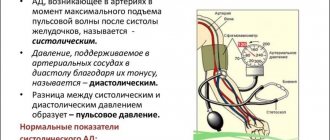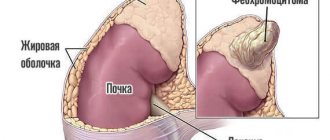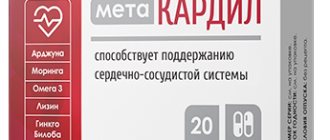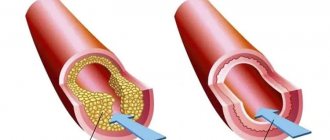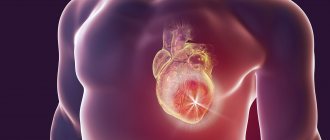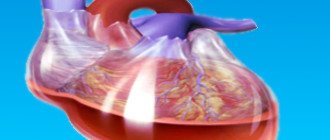If the symptoms of a pre-infarction condition can be identified, then this can save from disability and death. Heart damage does not develop out of nowhere; it will always be preceded by certain changes in the body. Sometimes they are asymptomatic, but they can always be identified using symptoms and examination data. Today, heart attack occupies a leading position as a cause of mortality. The best treatment for it is prevention, which is carried out with the help of medications, surgeries, and lifestyle changes.
Main forms of pre-infarction condition
In medical practice, a pre-infarction condition is defined as unstable angina.
.
It develops against the background of incorrect or incomplete treatment, stress and various complications. In some cases, this condition can be treated independently, after which the person quickly recovers. Pre-infarction includes the following:
- Tension angina that occurs in a person for the first time.
- Tension progressive angina pectoris, when attacks of a similar condition have already occurred in the past. It is characterized by a more pronounced pain syndrome, irradiation of a burning sensation and squeezing.
- Angina pectoris at rest, which develops after the exertion phase. Usually occurs after intense physical activity and other types of stress.
- Early post-infarction angina - pain in the left side appears 1-30 days after a heart attack.
- Angina pectoris that appears after bypass surgery occurs due to disruption of blood flow by atherosclerotic plaques.
- Prinzmetal angina, developing against the background of spasm in the large coronary arteries. Characterized by severe pain in the heart area in the morning.
Symptoms of pre-heart attack
Conventionally, the signs of a pre-infarction state can be divided into those that appear over several weeks, months, and into those that appear over several hours or days. In practical medicine, such terminology is not used. If we are talking about the long term, then, according to modern standards, it is customary to evaluate risk factors and the development of cardiovascular complications over the next 10 years. Immediately before a heart attack, some authors identify a prodromal period (a period of nonspecific symptoms).
Thus, the pre-infarction state can be divided into three stages:
- Changes in the body that form the “soil” for a heart attack.
- Period of nonspecific symptoms.
- Acute coronary syndrome is a condition when, until all tests are obtained, it is impossible to determine whether myocardial death has occurred or not.
Conditions that contribute to the development of a heart attack
The risk of fatal complications from the cardiovascular system (heart attacks, strokes) is calculated based on the SCORE scale. It allows you to estimate the chance (in percentage) of a heart attack or stroke occurring within the next 10 years.
Also takes into account the main risk factors:
- Blood pressure numbers.
- Floor.
- Age.
- Tobacco smoking.
- Blood cholesterol level.
However, the SCORE scale is not perfect. It is not suitable for young patients (under 40 years old), and does not take into account concomitant diseases, heredity, lifestyle and many other nuances. However, it is suitable for initial risk assessment in an outpatient setting or at home.
Factors that significantly increase the risk of coronary artery thrombosis include:
- Early cardiovascular pathology in close relatives.
- Male gender.
- Age over 40 years.
- Nicotine addiction.
- High blood pressure (more than 140/90 mm Hg).
- High level of total cholesterol (more than 5.0 mmol/l).
- High levels of low-density lipoproteins and triglycerides, even with normal total cholesterol levels.
- Early development of signs of atherosclerosis.
- Diabetes mellitus and other endocrine pathologies.
- Overweight.
- Sedentary lifestyle.
Cardiac ischemia
The section on coronary heart disease (CHD) includes all conditions associated with impaired blood flow through the arteries supplying the myocardium. These pathologies include: stable and unstable angina, heart attacks, diffuse cardiosclerosis.
To one degree or another, the appearance of signs of IHD should be regarded as a step towards myocardial infarction (MI). All these processes are links in one chain and are associated with disruption of coronary blood flow.
Angina pectoris is an attack of pain in the heart area associated with physical or emotional stress. Pain syndrome is a consequence of oxygen starvation of the myocardium. Stable angina is characterized by persistence of symptoms that occur during exercise. Unstable angina is the first occurrence of symptoms of the disease or symptoms against the background of a lesser load that was previously tolerated normally.
Unstable angina without treatment significantly increases the risk of developing myocardial infarction. At the same time, long-term persistence of stable angina even slightly improves the prognosis for MI. Over a long period of time, vascular collaterals have time to form, which will significantly reduce the area of necrosis in the event of a heart attack.
Acute coronary syndrome
In clinical practice, there is the concept of acute coronary syndrome. This is a condition when there is a clinical picture similar to a heart attack or progressive angina, but according to ECG and laboratory tests it is not possible to reliably establish a diagnosis. In essence, ACS is a period of time when it is not known for certain whether a section of the myocardium has died or not.
The symptoms of unstable angina and myocardial infarction are often extremely similar. In the classic version, they manifest themselves as pressing, burning pain in the area of the heart, the left half of the chest. They last for more than 20 minutes and are not eliminated by taking nitrates. They can radiate to the left arm, shoulder blade, back, lower jaw. Less often they occur in the form of pain in the upper abdomen, simulating problems with the digestive system.
In ACS, blood pressure (BP) may increase, decrease, or remain within normal limits. Developing rhythm disturbances can cause circulatory failure, resulting in a drop in blood pressure and impaired consciousness.
Prodromal period
Some authors identify a prodromal period of MI. It lasts from several days to a week. Symptoms at this stage are extremely nonspecific and it is almost impossible to predict the development of a heart attack from them.
As a rule, they are determined after the fact:
- It begins after physical or emotional stress. Sometimes associated with minor but constant stress.
- The appearance of angina attacks or their increase in frequency, as well as their development with little physical activity - all this is interpreted as unstable angina.
- Reduced effectiveness of nitrates (nitroglycerin, Nitrolong, etc.).
- Fast fatiguability.
- An unmotivated feeling of weakness.
- Deterioration of emotional background, anxiety, sleep disorders.
Common warning signs of the disease
At first, a pre-infarction condition can easily be confused with a common cold. Because of this, many sick people do not pay attention to this problem for a long time - they do not even suspect a serious disturbance in the functioning of the heart.
Vegetative-vascular dystonia, or VSD, is a clinical deviation that consists of disorders in the functioning of internal organs that are very diverse in manifestation and origin. Read more in the article: “symptoms and treatment with VSD drugs in adults.”
40-60 minutes before a heart attack, a person may experience the following symptoms:
- chest discomfort;
- aching bones;
- general malaise;
- change in normal body temperature in both directions.
It should be noted that in women it is much more difficult to determine the pre-infarction state than in men
. Such a serious cardiovascular abnormality is diagnosed after the fact. Pensioners and diabetics tolerate signs of a pre-infarction condition more easily. Due to the increased pain threshold, they can endure discomfort for a long time and not give it any importance.
If you have been experiencing discomfort for a long time without an obvious reason, try to consult a doctor for a detailed diagnosis.
Pre-infarction warning signs also include difficulty breathing, blue discoloration of the nasolabial triangle, pain in the left side of the chest, dizziness and fainting. Contact your doctor immediately if any of these signs appear.
Finding the answer
Please answer, what letter is the first letter of the root in the word “pre(s)incubation”?
Russian help desk response
Russian help desk response
Hello! How to write correctly: pre-infarction state - pre-infarction state. After the Russian consonant prefix there should be Y, right?
Russian help desk response
In the “word check” section on the website, the word “post-Imperial” is suggested to be written through I, and pre-integral and integrand – through Y. What is the difference? What does the Rule sound like, if there is one?
Russian help desk response
The difference is that the prefixes and under. Russians, and the prefix is post. foreign language. The letter ы instead and is written only after Russian prefixes ending in a consonant (except for the prefixes super- and inter-). After foreign language prefixes and persists: hyperinflation, disinformation, disintegration, counter-play, post-impressionism, post-infarction (cf. pre-infarction).
Good evening! I am an anesthesiologist-resuscitator. In the design of special documentation, the word “infusion” is often used, meaning “infusion - the introduction of a substance, most often into a vein (intravenous infusion).” Sometimes we carry out (before some anesthetic procedures) a so-called pre-infusion, that is, a kind of infusion that precedes the operation. I applied the word “predyn fusion” to this action in accordance with the rule about “spelling the vowels Y and I after prefixes ending in a consonant, with a root or with another prefix that begins with i.” Moreover, having studied specialized literature, I have repeatedly encountered “my” version of the spelling of this word. Moreover, I met it on the official websites of the Ministry of Health, the Higher Attestation Commission, in abstracts of candidate’s and doctoral dissertations, that is, in documents that were quite responsible and, undoubtedly, underwent strict regulatory control. Please explain which of the options (pre-infusion, pre-fusion) is correct, and if both options have the right to exist, then which of them is more consistent with the literary norm. Sincerely, Alexander.
Russian help desk response
Both options are spelling correct: from the Russian pre-. and English pre-infusion.
Dear Certificate! How to write correctly in a work on philosophy - pre-intelligentsia or pre-intelligence? On the one hand, there is a rule: after prefixes ending in a consonant, the letter Y is written at the root instead of the initial I. On the other hand, there is a dictionary fixation of the word “post-industrial”, which does not obey this rule. We hope for a quick response, as the doctoral defense is just around the corner.
Russian help desk response
Fast. – foreign language prefix. After prefixes of foreign origin and does not change to s. And here's the prev. – Russian prefix, after it it is written ы: predyn telligentsia. Wed. also: pre-infarction, but post-infarction.
Good afternoon. Please tell me which term is more correct from the point of view of the Russian language: preimplantation, preimplantation or preimplantation? (we are talking about diagnostics before implantation). Thank you in advance for your response!
Russian help desk response
There is no dictionary fixation for this word. After the Russian prefix pre-, meaning 'before something', the correct spelling of the root is with ы: pre-implantation. Wed: predyn farktny.
Hello, tell me which is correct: pre-infarction state or pre-far attack? Thank you
Russian help desk response
Correct: pre-infarction (but post-infarction).
Dear ladies/gentlemen! Please tell me what is the correct spelling: “preinspection” or “pre-inspection”? According to the rules, it seems there should be an “s” after the consonant, but isn’t this an exception for foreign words, as in the case of “disinfection”. Thanks in advance!
Russian help desk response
That's right: predyn special. It is important here that the prefix is not foreign language.
Tell me how to write the pre-integral table, pre-integral rendering - with I or Y after the prefix?
Russian help desk response
Why is the letter “i” after the prefix “vz”.
The word is “Collect” After all, according to the rule, after a Russian prefix ending in a consonant there is always the letter “ ы ”, and here “ and ”! Why . (previous farktny, notorious, play, etc.)
Russian help desk response
Take (like the previous farktny) is written in accordance with the pronunciation.
Pre-industrial or pre-industrial?
Russian help desk response
Please tell me if the spelling of the word “pre-industrial” is correct? As far as I remember, after the pre-letter “and” is replaced by “s”, however in this case such a spelling seems very strange to me. Thanks in advance for your answer.
Russian help desk response
Yes, the spelling predyn industrial is correct.
Which is correct, “pre-stroke” or “pre-stroke”? Was it once correct to write “pre-stroke”? If yes, then when?
Russian help desk response
Standard spelling: predyn s u ltny.
What is the correct spelling: “predyn spektsionny” or “pre-inspection”? What rule applies here? Thank you!
Russian help desk response
That's right: predyn special. When combining a prefix ending in a consonant with a root or with another prefix that begins with and, it is written, according to the pronunciation, according to the general rule ы, for example: search, previous, take, seize (but: collect, where pronounced and), summarize, unartificial, again, unprincipled, uninitiative, uninteresting, improvise, supra-individual, background.
Source of the article: https://new.gramota.ru/spravka/buro/search-answer?s=%D0%BF%D1%80%D0%B5%D0%B4%D1%8B%D0%BD
Disguised signs of pre-infarction
Advertising:
Myocardial infarction
– a disease of the cardiovascular system that can be asymptomatic.
Of course, in 70-90% of cases, certain signs of damage still appear, but in other people this condition can be disguised for a long time as some other chronic illness. The most common other types of attack are:
Bedsores are a pathological change in the skin and fatty tissue caused by a neurotrophic disorder. Most often occurs in bedridden patients or people who are in the process of rehabilitation from a heart attack, stroke, paralysis or complex fractures. Read more in the article: “treatment of bedsores with folk remedies at home.”
| Option | Symptoms | Frequency of propagation |
| Asthmatic | Shortness of breath, rapid heartbeat, suffocation, mild or no pain | About 10% of all heart attacks, occurs mainly in the elderly |
| Gastralgic | Pain in the upper abdomen, nausea, vomiting, hiccups and belching, bloating | In 5% of cases, most often diagnosed with low myocardial infarction |
| Arrhythmic | Abnormal heartbeat, mild pain, general malaise | In 1-5% of all cases |
| Cerebrovascular | Dizziness, loss of space, loss of consciousness, vomiting | 5 to 10%, most common in older adults |
| Asymptomatic | Absent, myocardial infarction is diagnosed only by ECG results | Varies from 0.5 to 20%, most often found in diabetics. |
Prognosis and prevention
All cases of pre-infarction conditions, as well as the heart attacks themselves, are extremely diverse and any prognosis largely depends on the individual patient. The degree and location of narrowing of the artery, concomitant pathology, and existing heart disease play an important role.
If MI does occur, sick leave is issued for 3-4 months. The period of disability for angina pectoris is about 10-15 days. The patient's further condition plays an important role. In case of severe consequences, it is possible to extend sick leave to 60 days and, in some cases, to register disability.
The rehabilitation period includes the selection and constant use of medications, proper nutrition, and dosed physical activity. The diet should limit salt intake to 1.5 g per day and exclude fatty and fried foods.
To fully restore working capacity, stenting may be necessary as planned. In general, rehabilitation after unstable angina takes significantly less time and effort than after myocardial infarction. However, without appropriate measures, the risk of developing MI is extremely high.
Did you like the article? Save it!
Still have questions? Ask them in the comments! Cardiologist Mariam Harutyunyan will answer them.
Ivan Nekrasa
Graduated from Rostov State Medical University with a degree in General Medicine.
The first signs of pre-heart attack in women
When the first signs and symptoms appear
Pre-heart attack in women should immediately consult a doctor - perhaps you will be able to stop the attack and prevent the development of a full-fledged myocardial infarction.
The first warning signs of this condition appear long before cardiovascular damage, which gives you the opportunity to identify pre-infarction in the early stages yourself. You should pay the most attention to the following warning signs:
Advertising:
- regularly recurring attacks of weakness;
- recurrent chest pain, regardless of the exact location;
- constant lack of air.
If such signs appear, you should immediately consult a cardiologist. Using timely diagnostic methods, he will be able to determine the pre-infarction condition in the early stages. It is enough for the treating specialist to conduct an ECG
, based on the results of decoding which he will be able to make an accurate diagnosis. When true signs of a pre-heart attack appear, the woman is sent to the hospital for intensive care.
PRE-INFARCTION
Devoted Pran Pride Pra Peter Firecracker Perth Feathered Perka Pentane Foam Penka Penates Foam Bakery Pecan Peck Pedagogical Faculty Pedant Ped Pean Pater Pat Parfen Partner Parter Parter Parquet Parquet Parker Park Steamed Antlers Punk Pandects Pandect Pan Pact Package Package Packer Pak Pai Ration Padre Current Ntr Oil Nef Non-woven Seal Nerka Sockeye Ner Gypsy Nenka Nectar Nectar Uncovered Uncovered Undyed Subsoil Ned Naften Naft Natr Natek Nary Nary Narc People's Deputy Nard Nant Nakr Night Nay Kyr Covered Crepe Kren Kraft Multiple Crater Krater Krat Krap Crane Crane Extreme Edge Stolen Knyr Kntar Knr Knr Kren Chum salmon Kern Kenaf Kenar Ken Keif Cedar Ked Kea Kafr Cafe Cafe Quatrain Quatrain Kater Kater Kat Carter Carter Karp Karny Karet Karen Kare Card Capter Caper Caper Cap Kant Kand Kan Kaif Kiter Kite Frame Cadet Jena Era Food Hole Hole Melon Dy Dryn Drain Drek Drift Drap Drap Draped Dry Dried Dna Dnepr Dyan Detny Baby Baby Sod Der Dep Day Den Descartes Deccan Dec Date Donated Gift Dante Dante Given Dan Dak Afft Atrek Aryk Artek Art Precancer Pre-infarction Ptr Ark Arena Pyr Wheat Rent Aren Tortured Torture Raek Ryder Arek Cancer Rocket Rand Ranet Ant Questionnaire Rapny Anker Andrey Andre Actor Akr Adept Aden Military Act Akyn Ankh Anchor Welt Early Apk Wounded Arden Ardenny… see
1) Spelling of the word: preinfarction2) Stress in the word: preinfarction3) Dividing the word into syllables (word hyphenation): preinfarction4) Phonetically... see
pre-infarction, pre-infarction, pre-infarction, pre-infarction, pre-infarction, pre-infarction, pre-infarction, pre-infarction, pre-infarction, pre-infarction, pre-infarction, pre-infarction, pre-infarction pre-infarction, pre-infarction, pre-infarction, pre-infarction, pre-infarction, pre-infarction, pre-infarction, pre-infarction, pre-infarction, pre-infarction, pre-infarction, pre-infarction, pre-infarction nym, pre-infarction, pre-infarction, pre-infarction, pre-infarction, pre-infarction, pre-infarction, pre-infarction, pre-infarction, pre-infarction, pre-infarction, pre-infarction, pre-infarction (Source : “Complete accentuated paradigm according to A. A. Zaliznyak”). Synonyms: premorbid, premorbid... see
pre-infarction, pre-infarction, pre-infarction, pre-infarction, pre-infarction, pre-infarction, pre-infarction, pre-infarction, pre-infarction, pre-infarction, pre-infarction, pre-infarction, pre-infarction infarction, pre-infarction, pre-infarction, pre-infarction, pre-infarction, pre-infarction, pre-infarction, pre-infarction, pre-infarction, pre-infarction, pre-infarction, pre-infarction, pre-infarction, pre-infarction, pre-infarction, pre-infarction, pre-infarction, pre-infarction, pre-infarction, pre-infarction, pre-infarction, pre-infarction, pre-infarction, pre-infarction, pre-infarction... look
prefix – PRED; root – YNFARKT; suffix – N; ending – ІY; The basis of the word: PREFARKTN Calculated method of word formation: Prefix-suffixal... see
Stress in the word: preinf'arktnyyStress falls on the letter: aUnstressed vowels in the word: preinf'arctny
pre-infarction, pre-morbid, pre-morbid Dictionary of Russian synonyms. pre-infarction adj., number of synonyms: 3 • pre-painful (3) • pre-infarction (1) • premorbid (2) Dictionary of synonyms ASIS.V.N. Trishin.2013. . Synonyms: premorbid, premorbid... see
pre-inf'arctic Synonyms: pre-morbid, premorbid
adj.med.peredinfarction
pre-infarction Synonyms: pre-painful, premorbid
-Synonyms: premorbid, premorbid
adj. pre-infarction state - preinfarto m Italian-Russian Dictionary.2003. Synonyms: premorbid, premorbid
{血管}硬塞前的Synonyms: premorbid, premorbid
Initial form – Preinfarction, accusative case, singular, masculine, inanimate
pre-infarction adj. 1) Such as happens before a heart attack. 2) Preceding a heart attack.
PRE-INFARCTION adjective 1) Such as happens before a heart attack. 2) Preceding a heart attack.
Alda's heart attack; n. condition of heart attack Aldy Khale
pre-infarction premorbid, pre-painful
pre-infarction pre-infarction
Natural science. encyclopedic Dictionary
(pre-infarction state), change in the nature of angina attacks (their frequency, intensification, resistance to drugs, the appearance of attacks ... see
Modern encyclopedic dictionary
PRE-INFARCTION PERIOD (pre-infarction state), a change in the nature of angina attacks (their frequency, intensification, drug resistance, the appearance of attacks at rest) in many patients with coronary heart disease several days (weeks) before the occurrence of myocardial infarction.
… look
Big Encyclopedic Dictionary
PRE-INFARCTION PERIOD (pre-infarction state) - a change in the nature of angina attacks (their frequency, intensification, resistance to drugs, the appearance of attacks at rest) in many patients with coronary heart disease several days (weeks) before the occurrence of myocardial infarction. … look
Large encyclopedic dictionary
– (pre-infarction state) – a change in the nature of angina attacks (their frequency, intensification, resistance to drugs, the appearance of attacks at rest) in many patients with coronary heart disease several days (weeks) before the onset of myocardial infarction…. look
Encyclopedic Dictionary of Natural Sciences
PRE-INFARCTION PERIOD (pre-infarction state), a change in the nature of angina attacks (their frequency, intensification, drug resistance, the appearance of attacks at rest) in many patients with coronary heart disease several days (weeks) before the occurrence of myocardial infarction... look
Large encyclopedic dictionary
PRE-INFARCTION PERIOD (pre-infarction state), a change in the nature of angina attacks (their frequency, intensification, drug resistance, the appearance of attacks at rest) in many patients with coronary heart disease several days (weeks) before the onset of myocardial infarction... look
Source: https://rus-orthography-dict.slovaronline.com/25642-%D0%BF%D1%80%D0%B5%D0%B4%D1%8B%D0%BD%D1%84%D0%B0 %D1%80%D0%BA%D1%82%D0%BD%D1%8B%D0%B9
Source: ososudahj.ru
Symptoms of pre-infarction in women
A clear symptom of pre-heart attack in women is severe heart pain.
, which cannot be stopped with any pills. Such attacks are repeated more and more often every day, and can recur up to 20-30 times a day. Most often, the greatest discomfort haunts a woman at night when she is at rest.
Female pre-infarction has a blurred clinical picture - it is quite difficult to recognize this condition.
All this leads to the death of the heart muscles, which subsequently negatively affects the speed of recovery. Heart pain may radiate to the right side of the body.
A pre-infarction condition can be recognized by the following symptoms:
- inability to take a deep breath;
- the appearance of fear, anxiety, strong excitement;
- pain in the shoulder joints;
- violation of spatial coordination;
- coldness of the extremities, the appearance of cold sweat.
It should be noted that the pre-infarction condition can manifest itself differently in each person: some people have all these symptoms, while others have none. Shortly before myocardial infarction, the patient begins to complain of insomnia, constant dizziness, weakness, lethargy, and constant nausea. The woman’s behavior also changes: she becomes more aggressive and irritable.
PRE-INFARCTION
See what PRE-INFARCTION is in other dictionaries:
PRE-INFARCTION
Devoted Pran Pride Pra Peter Firecracker Perth Feathered Perka Pentane Foam Penka Penates Foam Bakery Pecan Peck Pedagogical Faculty Pedant Ped Pean Pater Pat Parfen Partner Parter Parter Parquet Parquet Parker Park Steamed Antlers Punk Pandects Pandect Pan Pact Package Package Packer Pak Pai Ration Padre Current Ntr Oil Nef Non-woven Seal Nerka Sockeye Ner Gypsy Nenka Nectar Nectar Uncovered Uncovered Undyed Subsoil Ned Naften Naft Natr Natek Nary Nary Narc People's Deputy Nard Nant Nakr Night Nay Kyr Covered Crepe Kren Kraft Multiple Crater Krater Krat Krap Crane Crane Extreme Edge Stolen Knyr Kntar Knr Knr Kren Chum salmon Kern Kenaf Kenar Ken Keif Cedar Ked Kea Kafr Cafe Cafe Quatrain Quatrain Kater Kater Kat Carter Carter Karp Karny Karet Karen Kare Card Capter Caper Caper Cap Kant Kand Kan Kaif Kiter Kite Frame Cadet Jena Era Food Hole Hole Melon Dy Dryn Drain Drek Drift Drap Drap Draped Dry Dried Dna Dnepr Dyan Detny Baby Baby Sod Der Dep Day Den Descartes Deccan Dec Date Donated Gift Dante Dante Given Dan Dak Afft Atrek Aryk Artek Art Precancer Pre-infarction Ptr Ark Arena Pyr Wheat Rent Aren Tortured Torture Raek Ryder Arek Cancer Rocket Rand Ranet Ant Questionnaire Rapny Anker Andrey Andre Actor Akr Adept Aden Military Act Akyn Ankh Anchor Welt Early Apk Wounded Arden Ardenny. look
PRE-INFARCTION
1) Spelling of the word: preinfarction2) Stress in the word: preinfarction3) Dividing the word into syllables (word hyphenation): preinfarction4) Phonetically. look
PRE-INFARCTION
pre-infarction, pre-infarction, pre-infarction, pre-infarction, pre-infarction, pre-infarction, pre-infarction, pre-infarction, pre-infarction, pre-infarction, pre-infarction, pre-infarction, pre-infarction pre-infarction, pre-infarction, pre-infarction, pre-infarction, pre-infarction, pre-infarction, pre-infarction, pre-infarction, pre-infarction, pre-infarction, pre-infarction, pre-infarction, pre-infarction nym, pre-infarction, pre-infarction, pre-infarction, pre-infarction, pre-infarction, pre-infarction, pre-infarction, pre-infarction, pre-infarction, pre-infarction, pre-infarction, pre-infarction (Source : “Complete accentuated paradigm according to A. A. Zaliznyak”). Synonyms: premorbid, premorbid. look
PRE-INFARCTION
pre-infarction, pre-infarction, pre-inf.
y, pre-infarction, pre-infarction, pre-infarction, pre-infarction, pre-infarction, pre-infarction, pre-infarction, pre-infarction, pre-infarction, pre-infarction, pre-infarction, pre-infarction, popredynfa'rktney. look
PRE-INFARCTION
prefix – PRED; root – YNFARKT; suffix – N; ending – ІY; The basis of the word: PREINDIFARCTN Calculated method of word formation: Prefix-suffixal. look
PRE-INFARCTION
pre-infarction, pre-morbid, pre-morbid Dictionary of Russian synonyms. pre-infarction adj., number of synonyms: 3 • pre-painful (3) • pre-infarction (1) • premorbid (2) Dictionary of synonyms ASIS.V.N. Trishin.2013. . Synonyms: premorbid, premorbid. look
PRE-INFARCTION
Stress in the word: preinf'arktnyyStress falls on the letter: aUnstressed vowels in the word: preinf'arctny
PRE-INFARCTION
pre-inf'arctic Synonyms: pre-morbid, premorbid
Source of the article: https://rus-orthography-dict.slovaronline.com/25642-%D0%BF%D1%80%D0%B5%D0%B4%D1%8B%D0%BD%D1%84%D0% B0%D1%80%D0%BA%D1%82%D0%BD%D1%8B%D0%B9
The first signs of pre-heart attack in men
Advertising:
A more accurate clinical picture is considered to be a distinctive black pre-infarction condition in men.
Representatives of the stronger sex are rarely diagnosed with this condition based solely on ECG
— usually when the first disturbances appear, men feel abnormalities in the functioning of the body.
Male pre-infarction has a more typical clinical picture; it is not difficult to determine the obvious symptoms of this condition in them.
For a long time before an attack, men suffer from unstable angina, which occurs mainly at rest. It cannot be controlled with medications and goes away on its own after some time. The following pre-infarction warning signs in men are also identified:
- increased fatigue, lack of vigor even after a long rest;
- sleep disturbances, insomnia, frequent awakenings;
- difficulty breathing, development of shortness of breath;
- causeless attacks of fear and anxiety;
- constant headache, decreased visual acuity;
- constant discomfort in the chest area;
- indigestion: nausea, vomiting, heartburn;
- pale skin, cold sweat.
When the first signs indicating a pre-infarction condition appear, try to immediately consult your doctor. The sooner you receive medical assistance, the faster you will be able to restore your body. Don't ignore discomfort
that cause you serious discomfort.
Treatment
Treatment for pre-infarction conditions is extremely multifaceted. If we are talking about the prevention of MI as such, then constant use of medications is important in relation to existing chronic diseases of both the cardiovascular and other systems. Patients with ACS and unstable angina are managed completely differently.
First aid
The main thing is to know what to do before the ambulance arrives in the event of a pre-heart attack. The patient must be treated with official medications; any folk remedies will simply not be effective enough against acute pathology.
First of all, you need to call an ambulance (EMS), measure your blood pressure and count your pulse. After this, emergency assistance begins, which necessarily includes:
- Taking nitroglycerin or other fast-acting nitrates. Take 1 tablet under the tongue 3 times with an interval of 5 minutes. Nitrates dilate the blood vessels of the heart, improving blood supply to the myocardium.
- Taking acetylsalicylic acid (Aspirin, Cardiomagnyl, Aspecard, etc.) and/or clopidogrel. 300 mg of Aspirin and/or clopidogrel is taken once. A smaller or larger dosage will not have the desired effect. These drugs prevent further formation of blood clots.
- Beta blockers. Used for tachycardia and rhythm disturbances. The most commonly used is metoprolol 5 mg every 5 minutes until the heart rate reaches 60 per minute. Not applicable for blood pressure less than 100/70 mm Hg. Art. Beta blockers also reduce myocardial oxygen demand.
- ACE inhibitors. They are used for high (to reduce blood pressure) or normal (to reduce the load on the myocardium) pressure. In case of emergency, captopril 25 mg should be used.
- Statins. Stabilizes atherosclerotic plaque. Statin tablets are chewed and swallowed. In the CIS countries, it is recommended to immediately use 80 mg of atorvastatin or 40 mg of rosuvastatin. American studies claim that it is more effective to take 200 mg of atorvastatin or 100 mg of rosuvastatin at once.
The EMS team continues the treatment that began. She can also administer narcotic analgesics to relieve pain, restore heart rhythm with medication or electrocardioversion, and combat other symptoms and complications. The patient is then transported to the hospital for coronary angiography. If the process takes more than 120 minutes and there are ECG criteria for MI, then thrombolysis is performed.
Resuscitation measures (indirect cardiac massage, artificial ventilation, defibrillation) are carried out only if there are signs of clinical death.
Treatment in hospital
Depending on the structure of medical institutions in a particular territorial entity, the patient may end up in a therapeutic, cardiology, heart attack department, intensive care unit or intensive care unit beds. In addition to ongoing drug therapy, coronary angiography is performed. If there has been occlusion of the heart arteries, a stent is installed to restore blood flow. In the case of unstable angina, planned stenting is possible, which will ensure the prevention of MI.
Symptoms of pre-infarction in men
Symptoms and first signs of pre-heart attack in men completely depend on how this disease proceeds: typically or apathetically
. For diagnosis, only the second type presents difficulties, in which heart disease is disguised as other ailments of the digestive, respiratory or other system.
For the typical and most common case, the symptoms of pre-heart attack in men are as follows:
- The appearance of acute intense pain that spreads to the entire chest. Also, such discomfort can spread to the left shoulder or collarbone, neck, teeth, and can radiate to the ear or the area between the shoulder blades.
- Attacks of heart pain have a wave-like character: they either intensify or subside. This phenomenon cannot be stopped by Nitroglycerin and lasts from several hours to 3-5 days.
- Painful sensations can be different: pressing, sharp, bursting. The larger the surface of the damaged muscle layer of the heart, the stronger the pain.
- The appearance of a feeling of extreme fear, excessive agitation - in some cases, on the contrary, shortness of breath and weakness occur.
- Blood pressure levels rise rapidly and then drop sharply.
- Arrhythmia and tachycardia are observed, which cannot be stopped with pills.
- Cold sweat appears, the skin becomes pale.
A distinctive sign of pre-heart attack in men is clear and easily distinguishable symptoms. The stronger sex is characterized by a classic variant of the development of this disease, in which severe chest pain predominates. Do not endure pain and discomfort - call an ambulance immediately.
What to do if signs of a pre-heart attack appear?
Advertising:
When the first signs of pre-infarction appear, immediate drug therapy is necessary. This will help not only save life, but also subsequently quickly restore the body to its normal state. Call an ambulance immediately if you have chest pain, and before it arrives, do the following:
- sit on a chair, place pillows under the head;
- get rid of tight clothes, unbutton your shirt and remove all accessories from your neck;
- put Nitroglycerin under your tongue, renew the tablet every 5 minutes, but no more than 3 times;
- dissolve an effervescent tablet of Aspirin and Plavix in a glass of water and drink the medicine - this will help thin the blood;
- in the absence of an ambulance for a long time, the patient must be administered Baralgin or Analgin intramuscularly to reduce pain.
You should not ignore the first signs of a pre-infarction condition - as soon as you experience any discomfort in your heart, you should immediately consult a doctor. You may be able to get rid of this phenomenon and prevent it from developing into a full-fledged heart attack. Also, the timeliness and completeness of drug therapy determines how completely the body can be restored.
(no title)
?
| Pre-infarction or pre-infarction....? There is some confusion here. |
| October 18, 2006 20:11 (UTC) |
In what given is this? “and” does not turn into “y” only with foreign prefixes. RTFM. (Reply) (Parent) (Thread)
| From: Date: ex_ne_spits |
| October 19, 2006 03:20 (UTC) |
Look at the place where it says that this is an exception - maybe I’ll believe it. but, you know, at school we wrote this word in vocabulary dictations =)) (Reply) (Parent) (Thread)
| From: Date: 03spb |
| October 18, 2006 17:03 (UTC) |
in all medical literature, both pre-infarction...so post-infarction is written with an “I”...an exception to the rule...
| From: Date: nomen_n |
| October 18, 2006 18:54 (UTC) |
What are you saying? I looked at the first 5 books I came across from my home library, for example, Syrkin’s classic monograph on myocardial infarction, where this term is used, everywhere is “pre-infarction”? (Reply) (Parent) (Thread)
| From: Date: city_rat |
| October 18, 2006 17:04 (UTC) |
According to the rules, of course, pre-infarction (see any dictionary). But among doctors (due to their illiteracy :)) spelling with “I” is so established that, probably, this should be considered acceptable professionalism.
| From: Date: city_rat |
| October 19, 2006 06:33 (UTC) |
1. Of course, there are mistakes. But any professionalism, in essence, is a mistake. According to dictionaries you should say “kompas”, but sailors say “kompas”. The mistake with “pre-infarction” is so widespread and many doctors (including authoritative speakers - university teachers, etc.) defend this spelling so stubbornly that, in my opinion, it makes sense to talk about a specific professional spelling. One of the justifications that I heard from doctors, by the way, was brought by the computer era: “when we need to find everything related to a heart attack in a huge monograph, the letter “s” interferes with us.” Of course, unlike “kompAs”, this professionalism has not [yet] been codified. And _I_ would not use it, incl. and in professional literature.
2. From the point of view of the formal definition of a document - yes, a document.
(Reply) (Parent) (Thread)
| From: Date: alexanders2005 |
| October 19, 2006 07:00 (UTC) |
Thank you. Your arguments are clear. I just came across texts and “authoritative speakers” who preferred the option with the letter “s”. (Reply) (Parent) (Thread)
| From: Date: vovse_ne |
| October 19, 2006 09:45 (UTC) |
Yeah, and based on the fact that everyone, as one, says “agreements” instead of “agreements,” are we also changing the rule? (Reply) (Parent) (Thread)
| From: Date: city_rat |
| October 19, 2006 09:50 (UTC) |
Please take any rosenthal and read the section on slang, professionalism, etc. If after this you still have questions, come back. (Reply) (Parent) (Thread)
| From: Date: aldor |
| October 23, 2006 10:36 (UTC) |
find everything related to a heart attack, the letter “s” prevents us
Poor, poor doctors... Nobody convinced them that the contextual search for “heart attack” works no worse than the contextual search for “heart attack”, and no letter “s” gets in the way... Although the idea is fruitful: to justify language illiteracy with computer illiteracy.
Okay, okay, let them write as they want, just treat them. ?
(Reply) (Parent) (Thread)
| From: Date: city_rat |
| October 19, 2006 06:35 (UTC) |
Source: https://pishu-pravilno.livejournal.com/2301393.html


